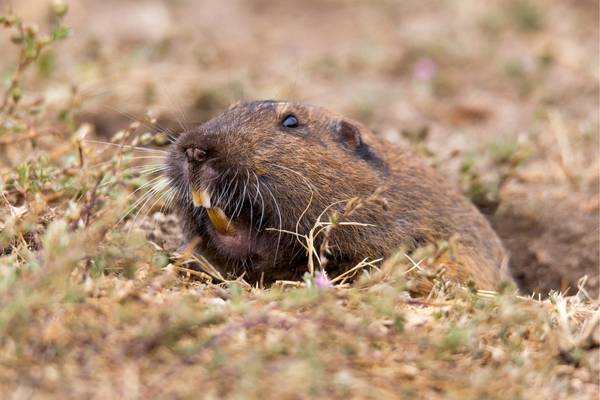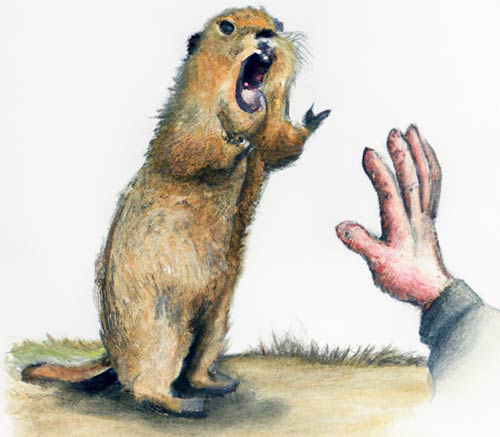There’s a lot of misinformation and misunderstanding about gophers. People often ask if gophers bite, which is a natural question to ask – if you’ve never been bitten by one, that is!
The answer is yes, gophers can bite in self-defense! Gophers have sharp teeth that they use for digging and eating grasses and roots. They also use their teeth to defend themselves against predators like dogs, cats, or even us humans.
While a bite or scratch certainly has the potential to spread disease, the transmission of disease from a gopher to a human is almost never reported and is therefore considered extremely rare.
There are several ways to prevent gopher attacks. The best way is to keep your distance and avoid provoking them. Another way is to simply apply one of the strategies that keep them entirely out of your yard.
If you have caught a gopher and want to handle it, make sure to wear thick gloves and long pants to protect your skin.
Finally, if an accidental bite should happen, be sure to clean any wounds immediately and thoroughly to reduce the risk of infection!
Contents
Gophers do bite and it can be quite painful.
Gophers are rodents, so you can probably guess that they do bite other animals to some extent. But the truth is that gophers really only bite in defense and if they feel cornered or injured. They aren’t aggressive creatures by nature.
Gophers, like most animals, are much more afraid of you than you are of them and they will only harm you if they feel that you will harm them!

They also don’t like to get too close to humans, so you are really in control when it comes to interaction with gophers and therefore the risk of being bitten.
You might think that since they’re animals, they’ll bite anyone who gets too close or feels threatening to them.
Unlike other rodents (like rats), gophers will only attack humans if they feel threatened or cornered by us – in fact, most of their interactions with people are peaceful ones.
What kind of teeth do gophers have?
Gophers have four types of teeth: incisors, canines, molars, and premolars.
The long front teeth of gophers are called the incisors and these are used for biting and digging although mostly used to chew through fibrous vegetables!
Like other rodents, gophers do not have canine teeth, but rather a gap between their molars and incisors.

When food has been bitten loose, the molars are used to grind down food so it’s easier to digest while the premolars help push food into the mouth when chewing.
The pocket gopher is a rodent of the Geomyidae family. Their distinctive fur-lined cheek pouches extend from the face to the shoulders. They use these to store food and bring it along to the food storage chambers of their tunnel systems underground!
The gopher’s teeth are long and prominent, and it can use its incisors as shovels to dig up plants and other debris.
When handling a gopher and you see its mouth open up or feel its teeth against your skin, it’s usually because they’re going in for an attacking bite.
This is when a gopher sinks their incisors into your skin as hard as they can-they do because they want to fight back against any danger from predators trying to eat them!
Why do gophers have big teeth?
Gophers are mostly herbivores, which means they eat lots of plants. They have big teeth so they can chew through all the roots and stems of plants, as well as the hard ground and clay that they dig into.
Yep, that’s right. They also use their teeth to dig through the hard ground and clay so they can build their tunnels.
Gophers use their incisors for digging, and their lips and throats can almost be closed behind them to keep most dirt out of their mouths.
This makes them excellent soil dwellers that spend most of their time underground – especially during winter!
What to do if a gopher bites you?
If a gopher bites you, the best thing to do is to immediately clean the wound with soap and water. Apply pressure if needed and seek medical attention.
If you are bitten by a gopher, take the following steps:
- Clean the wound with soap and water.
- Remove any large fragments of dirt in the wound with tweezers. Do not use your fingers, as you may introduce bacteria into the wound.
- Apply pressure on the wound with a clean towel to stop bleeding.
- If the bleeding doesn’t stop quickly, call your doctor.
- Apply a bandage if necessary to keep dirt and germs out of the wound. To prevent infection, you should change this every day or as needed.
Can gophers make dogs sick?
While humans are rarely infected by gophers, you’ve probably wondered, if gophers can make dogs sick?
The answer to this question is yes, but it depends on the gopher in question. Gophers are not poisonous to dogs per se, but if the gopher is sick, the dog could get sick, too.
Dogs can get sick from gopher bites, but there are many other ways that dogs can become sick from gophers e.g. by sniffing around their burrows or ingesting their feces.
Gophers carry parasites and bacteria that can make your dog sick. Some of these include the following:
- Salmonella (Diarrhea and worst case sepsis).
- E. coli (Escherichia coli can cause diarrhea and blood infections).
- Campylobacter (a bacteria that causes diarrhea).
- Leptospira interrogans (Causes leptospirosis that can cause liver failure and death).
But like other animals in your yard, dogs love to run after or play with animals like armadillos, which might also transmit diseases to dogs as well.
Do gophers have rabies?
A rat-like rodent, the gopher can be intimidating when it’s staring you down with its beady eyes. But don’t worry: gophers are not a rabies vector, nor are they a reservoir or carrier of the disease.
The virus that causes rabies is most often transmitted through saliva, typically from an infected animal like a dog or a fox biting another animal or human or from contaminated wounds or mucous membranes coming into contact with saliva from an infected animal.

The animals most often carrying and transmitting rabies are wild animals like bats, raccoons, skunks, and foxes, but gophers and most rodents are not on this list!
And there have been cases of humans contracting rabies after being bitten by rabid bats-so it’s possible that if your yard was infested with bats and one got loose in your house, you could still find yourself at risk for contracting this deadly virus (just as those who get bitten by dogs can contract distemper).
Can gophers get sick from rabies?
Yes. In theory they can, as rabies infects most warm-blooded animals. However, it is not as common for gophers to get rabies as it is for many other animals. In fact, it is extremely rare.
The absence of rabies in gophers is likely because gophers rarely interact with other larger animals and therefore don’t come into contact with the saliva of a rabid animal so they can contract the disease.
Therefore there is no conclusive evidence that gophers can contract rabies, and they are not typically considered carriers of the virus. However, we know that most other animals very similar to the gopher can contract it so we do expect that it can happen.
This is important because rabies can be deadly to humans, and even animals that contract it can die.
Gophers could potentially get sick from rabies if they were bitten by a rabid bat or another infected animal, which would then put any humans who came in contact with the gopher at risk for contracting the virus.
There is no cure for rabies once symptoms appear, so preventing exposure to the virus is critical. However, effective vaccines do exist but there is no reason to get them if gophers are the only source of potential exposure.
If you have been bitten by an animal or come into contact with saliva from a rabid animal, it is important to seek medical attention immediately as there is no cure for rabies once symptoms develop.
How to get rid of gophers?
The best way to make sure you and your children and pets do not get bitten by gophers is to figure out what got the gophers attracted to your yard in the first place and implement strategies to deter them.

Instead of killing gophers, I would strongly recommend one of the very effective solutions listed below:
1. Ultrasonic Sound Emitters
Groundhogs and gophers, as well as other animals that may invade your garden, tend to have very good hearing. This means that loud or consistent noises will scare them away or at least shorten their visits significantly!
One of my favorite technologies to keep pests away from my backyard is these cool solar-powered ultrasonic sound emitters that you can buy right off Amazon! In my experience, they really work, and the solar panels on top save you the time and money of changing batteries all the time.
These are effective and passive instruments that will surely deter gophers from your yard. The number you need to place depends on the size of your yard and how deep the tunnels of the gophers are.
2. Motion-activated sprinklers
Like most animals, gophers hate surprises, and they will run away if suddenly sprayed with water. I like this solution because it is humane, simple, effective, and does not require much time to set up and there are many models to choose from.
The Havahart 5277 is a motion-activated sprinkler that is activated by the movement of animals up to 25 feet away and sprays them with a harmless water jet, frightening them off and keeping them at bay.
The included metal stake makes it easy to install in your backyard, and the sprinkler can be rotated 180 degrees for maximum coverage.
3. Using Lights and Reflections
Groundhogs are nocturnal animals so they may avoid areas that have bright lights. Motion-activated lights, sounds, and sprinklers may help prevent gophers from entering your yard.
Placing CDs or tin foil and mirrors around your yard is another cheap and effective way to create light reflections that blind and scare gophers.
This may sound a little old-fashioned but it still works! The reflective surface of CDs or tin foil drives gophers crazy and will make them seek away from your plants.
You can use old CDs you no longer need or aluminum trays from takeaway containers, just make sure they reflect light well.
If you have a lot of plants to protect this way, it may be a good idea to invest in some commercial mirrors or electronic light emitters like the ones shown above.
4. Build a Fence
The most obvious and practical solution to protecting your plants from gophers is to install a fence around the patch. A fence should be at least 2 feet tall and sunk in the ground about 8 inches.
The best fencing material for this purpose is a cattle panel or hog panel as they are very sturdy and can withstand even quadruped animals such as goats, cows, and deer. However, most chicken fencing types will do. This will be strong enough to stop them from getting through while still allowing for airflow and sunlight.
If you don’t like the idea of building a fence around your entire onion patch then you can try fencing off only the area that your onions, tomatoes, or zucchinis are in; this will at least keep some of the gophers or gophers away from them.
5. Using Hot Pepper Or Garlic Spray
This is a good way to protect your vegetable plants or decorative flowers against pests such as gophers, rabbits, deer, and gophers. It will also protect your backyard against the neighbor’s cat that thinks it is fine to use your vegetable garden as a toilet.
You only need about 1 tablespoon of crushed chili pepper and garlic along with 1 cup of vinegar per half a gallon of water.
Spray this mixture on any exposed parts of the plant until completely covered. Make sure you reapply whenever rain washes away the spray.
6. Use Rodent Deterring Companion Plants
Instead of making a tincture out of strongly smelling plants, you can also just plant the plants themselves!
Companion planting is a good way of deterring animals like gophers from your garden. You can plant strong-smelling plants such as garlic, basil, lavender, and chives around your favorite vegetables.
These plants will keep rodents like gophers, gophers, and mice away because they don’t like the smell of these and they mask the smell of the delicious plants.
7. Using Artificial Repellent
You can use some of the commercially available repellents to protecting your vegetable plants against gophers, gophers, and other rodents.
You will need to be careful when using these though because some of them can end up harming you and your pets if not applied properly. Some of the commercial gopher repellents available include Shake-Away, Bonide Repels All, Critter Ridder, and Tom Cate Repellent.
8. Using a Scarecrow
Scarecrows may look a little funny in your garden, but they work surprisingly well. Just make sure your scarecrow is big and scary enough to deter gophers from getting anywhere near your tomatoes, zucchini, or backyard flowers! Also, you may need to replace the scarecrow every now and then as gophers will get used to it.
9. Using live traps
Using live traps to catch the gopher and drive it away to somewhere safe, but far away, is perhaps the best option if you want to get completely rid of gophers in your yard!
You can make a trap yourself with some wire and ingenuity…
But, you can also just buy a live trap, like the sturdy metal ones shown here:
Conclusion
Gophers bite as a defensive mechanism; most of the time it’s fine to leave them alone and they won’t bother you.
Gophers are not aggressive animals. They’re not interested in attacking or biting humans. Gophers may bite as a defensive mechanism, but it’s relatively unlikely that you will be bitten by one unless you try to handle them or otherwise startle them.
If you just leave gophers alone, they won’t bother you and will go about their business of eating plants and making burrows for themselves.





















